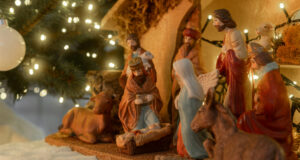Around the Lamp at Evening: A window into the beautiful mess of family life
Published on January 26, 2025

The Swedish artist Carl Larsson (1853-1919) is known for his watercolors of happy and picturesque family life. Although his own family of origin was less than idyllic, Larsson possessed a keen eye, for seeing the everyday beauty in ordinary life. In one of his paintings “Around the Lamp at Evening” (1900), Larsson invites us to pull up a chair at a bountifully disheveled table and reflect on a simple family ritual.
As the name would suggest, the first thing to catch our eye is the silver oil lamp at the center of the table. Its light radiates outward, spilling over the meal laid out on the table and illuminating the faces gathered around it.
The vase of vibrant poppies and rosey peonies offsets the metallic and mechanistic elements of the lamp with the softer beauty of the natural world. Despite the disheveled appearance of the tablescape, there is abundant beauty to be found in the details. The vase of flowers, the doilies lining the bread basket, and the matching plates show the forethought of the dutiful mother who hovers in the background holding the baby.
Despite the disheveled appearance of the tablescape, there is abundant beauty to be found in the details.
There is a sense of gentle, supernatural joy on each of the faces, but some very human elements are also on full display. One child leans with elbows on the table, the plates are out of order and misaligned, and the table is above capacity with no more space for food or people. The table is not flawless but it is undeniably lovely even in its messiness.
The family table, the shared meal
Gathering together at table has long been an essential part of human culture. A shared meal with those we love promises to offer warmth and sustenance for more than just the body. The table has a magnetic pull that draws us together just as it draws together the five children in the painting seated around it.
A shared meal with those we love promises to offer warmth and sustenance for more than just the body.
The mother lingers nearby, fully part of the moment, but tending to the no-doubt fussy baby who is too little to fully partake in the solid foods offered at the table. It is unclear in the painting if the meal is in progress, still in preparation, or has already been finished. Nonetheless, the spirit of gathering and togetherness is still very much alive in the scene. Perhaps this is what Larsson was most hoping to capture— a snapshot of a family experiencing the human good of community even in the imperfect surroundings.
“Around the Lamp at Evening” is a beautiful reminder of the messiness of family life. Larsson depicts the eternal glory that can be captured in a single seemingly mundane moment of childhood. Gathering at the table is not an empty action meant solely to feed ourselves as efficiently as possible, but rather it is an invitation into the communal reality of man. Just as the light of a lamp can draws us towards its beacon of light, so too does a shared meal draw individuals into deeper community.



